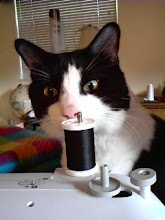-KMay
First let me say that I do NOT suggest using brocades or satins for projects if you are just starting out. These fabrics require a lot of care, energy and patience.
If you do decide to tackle this ravelly beast, however, it's best to use a SHARP size 10/70 needle or smaller, and satin pins. Brocade and satin scar very easily, so if you mess up your stitch and use a seam ripper to start again, you'll still have the holes where the needle first went in. Be very patient, you may have to trim away the frayed edges frequently, and use a larger seam allowance.
Where the edges fray, you have a few options. You can try using a special product made to reduce fraying, like No-Fray or Fray-Check. Trim away the frays and then run it along the edges and let it dry.
If you have one of the cheap brocades, like the ones they sell at JoAnns or Wal-Mart, and it's made of polyester or nylon, you can also try (MY HUSBAND IS A LAWYER) burning it. You can run a lighter along the edges until the frays curl up and melt. I assume no responsibility if you damage your fabric, burn yourself, or burn your house or anything else down.
Most of the cheap brocades can also be machine washed. Use the delicate cycle with cold water, and then hang it up to dry. You can iron them on cool, and I've even successfully used fusible interfacing on one.
Fray-checking it and burning it will make the edges feel "crunchy." In my opinion, the best way to work with it is to press and hem the edges. It keeps the edges soft and flexible.
If somehow you got your hands on a REAL silk brocade, dry clean only all the way.
As for the totebag straps, I make an X in a box where I attatch the handles. The totebag tutorial is coming along, but I'm new to using a video camera and all the movie making technology, and my husband keeps forgetting to teach me how to use it. I am, however, a MASTER when it comes to MS Paint! BEHOLD!

Love your blog so far - really helpful to an avid sewer but a bit of a newbie. I find fabric shops simultaneously candy-shop-exciting and overwhelming! What's your opinion on the best choice of fabrics to have in your stash? I mainly work with freebies and old clothes (currently too skint to buy much new) so it's usually a mix of jersey, stretchy knit, linen and denim, all seamed together (obviously, as they're old clothes!) leaving me with small pieces of fabric which I usually turn into children's clothes. I'm trying to build up a stash (at the moment it consists of some brown corduroy and some black jersey!) but go blank when I walk in a shop as to what I'm planning on making and what I need.... Wow, big ramble.
-Skippedydoodah
Skippedy-
I never thought I would be asked to give advice on which kind of fabric to hoarde. How about all of it?
It really depends on what kinds of projects you like to do. If you make a lot of crafts, like quilts, toys or home accessories (i.e. potholders) any kind of plain woven cotton is good to keep around. I myself am a sucker for cutesy prints, and if you're like me, it might be wise to buy a solid color that corresponds at the same time, so when you're ready to make that adorable apron or that convenient casserole cover, you dont get stuck looking for something that you could use for the accents. Cotton also is great for baby clothes, which you mentioned that you make already. Kids can pull off alot of those cute motifs.
If you make a lot of street clothes, I think it's good to stock up on the jersey/ interlock and bottomweight fabrics (denim, twill, anything that feels like pants). again, I think its good to have a stash of basic colors (black, white, tan, red and navy) So when you find a fabric you can't live without, you have something to accent it.
If you make a lot of suits or work clothes, again go for the plain cotton for shirts, but look for one with a higher quality or thread count. Most stores have a section specifically for suit fabric (jacket, skirt, dress pants, whatev). Charmeuse and chiffons make for great blouses, if you feel confident enough to sew with those fabrics. They are pretty tricky for the newbie seamstress.
If you make dresses, like cocktail dresses or fancy stuff, satins, taffetas, velvets, chiffons, and sheers are all good to have around. These ones are a little too intimidating to me though. I only get them if they are on sale or I have a project in mind.
If your bag is in home decor, don't keep a stash. That fabric is too expensive to just have lying around.
Regardless, I think it's always a good idea to keep a stash of muslin, different kinds and weights of interfacing, basic colors of lining, and elastic. Notions usually end up being more useful to have around than extra fabric, even though buying fabric is the most fun. :)
I hope this helps. Whenever I buy fabric, I get a cart and fill it up with stuff I like, and then when I get to the cutting counter, I weed out the ones that I can live without and just get the ones that I NEED. Everyone is different though.
My totebag tutorial should be up in about a week. Still trying to figure out how to use the camcorder.

